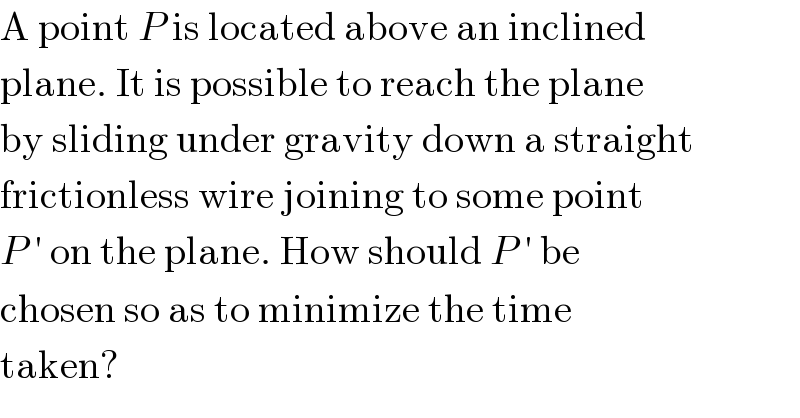
Question Number 18262 by Tinkutara last updated on 17/Jul/17

$$\mathrm{A}\:\mathrm{point}\:{P}\:\mathrm{is}\:\mathrm{located}\:\mathrm{above}\:\mathrm{an}\:\mathrm{inclined} \\ $$$$\mathrm{plane}.\:\mathrm{It}\:\mathrm{is}\:\mathrm{possible}\:\mathrm{to}\:\mathrm{reach}\:\mathrm{the}\:\mathrm{plane} \\ $$$$\mathrm{by}\:\mathrm{sliding}\:\mathrm{under}\:\mathrm{gravity}\:\mathrm{down}\:\mathrm{a}\:\mathrm{straight} \\ $$$$\mathrm{frictionless}\:\mathrm{wire}\:\mathrm{joining}\:\mathrm{to}\:\mathrm{some}\:\mathrm{point} \\ $$$${P}\:'\:\mathrm{on}\:\mathrm{the}\:\mathrm{plane}.\:\mathrm{How}\:\mathrm{should}\:{P}\:'\:\mathrm{be} \\ $$$$\mathrm{chosen}\:\mathrm{so}\:\mathrm{as}\:\mathrm{to}\:\mathrm{minimize}\:\mathrm{the}\:\mathrm{time} \\ $$$$\mathrm{taken}? \\ $$
Commented by Tinkutara last updated on 17/Jul/17

Commented by ajfour last updated on 18/Jul/17

Answered by ajfour last updated on 18/Jul/17

$$\mathrm{Perpendicular}\:\mathrm{from}\:\mathrm{P}\:\mathrm{to}\:\mathrm{incline} \\ $$$$\mathrm{be}\:\mathrm{D}. \\ $$$$\mathrm{let}\:\mathrm{time}\:\mathrm{taken}\:\mathrm{to}\:\mathrm{reach}\:\mathrm{P}'\:\:\mathrm{be}\:\mathrm{t}. \\ $$$$\mathrm{length}\:\mathrm{of}\:\mathrm{wire}=\mathrm{Dsec}\:\left(\frac{\pi}{\mathrm{2}}−\alpha−\theta\right) \\ $$$$\:\:\:\:\:\:\:\:\:\:\:\:\:\:\:\:\:\:\:\:\:\:\:\:\:\:\:\:\:=\frac{\mathrm{D}}{\mathrm{sin}\:\left(\theta+\alpha\right)} \\ $$$$\:\mathrm{acceleration}\:\mathrm{along}\:\mathrm{wire}=\mathrm{gsin}\:\theta \\ $$$$\frac{\mathrm{D}}{\mathrm{sin}\:\left(\theta+\alpha\right)}=\frac{\mathrm{gt}^{\mathrm{2}} \mathrm{sin}\:\theta}{\mathrm{2}} \\ $$$$\mathrm{t}^{\mathrm{2}} =\frac{\mathrm{2D}}{\mathrm{gsin}\:\theta\mathrm{sin}\:\left(\theta+\alpha\right)}\:>\mathrm{0} \\ $$$$\:\:\:=\frac{\mathrm{4D}}{\mathrm{cos}\:\alpha−\mathrm{cos}\:\left(\mathrm{2}\theta+\alpha\right)} \\ $$$$\mathrm{For}\:\mathrm{t}^{\mathrm{2}} \:\mathrm{to}\:\mathrm{be}\:\mathrm{minimum}, \\ $$$$\:\mathrm{denominator}\:\mathrm{is}\:\mathrm{a}\:\mathrm{maximum}. \\ $$$$\mathrm{that}\:\mathrm{is}\:\:\:\:\:\mathrm{cos}\:\left(\mathrm{2}\theta−\alpha\right)=−\mathrm{1} \\ $$$$\:\:\:\:\:\:\:\:\:\:\:\:\:\:\:\:\:\:\:\:\:\:\:\mathrm{2}\theta−\alpha=\pi \\ $$$$\:\:\:\:\:\:\:\:\:\:\:\:\:\:\:\:\:\:\:\:\:\:\:\:\:\:\theta=\frac{\pi}{\mathrm{2}}−\frac{\alpha}{\mathrm{2}}\:. \\ $$$$\mathrm{wire}\:\mathrm{is}\:\mathrm{then}\:\mathrm{the}\:\mathrm{angular}\:\mathrm{bisector} \\ $$$$\mathrm{of}\:\bot\:\mathrm{from}\:\mathrm{P}\:\mathrm{to}\:\mathrm{incline}\:\mathrm{plane}\:\mathrm{and} \\ $$$$\mathrm{vertical}\:\mathrm{line}\:\mathrm{from}\:\mathrm{P}\:\mathrm{to}\:\mathrm{incline}\:\mathrm{plane}. \\ $$
Commented by Tinkutara last updated on 19/Jul/17

$$\mathrm{Thanks}\:\mathrm{Sir}! \\ $$
